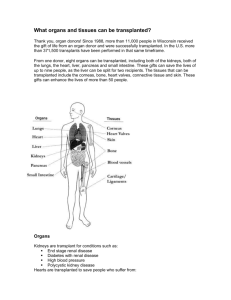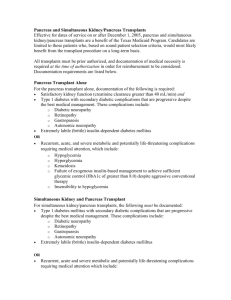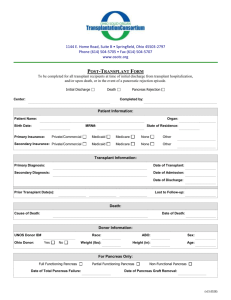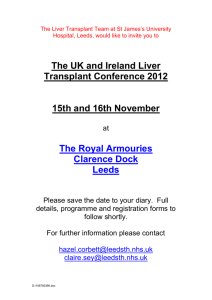LCNW_Transplantable Organs
advertisement
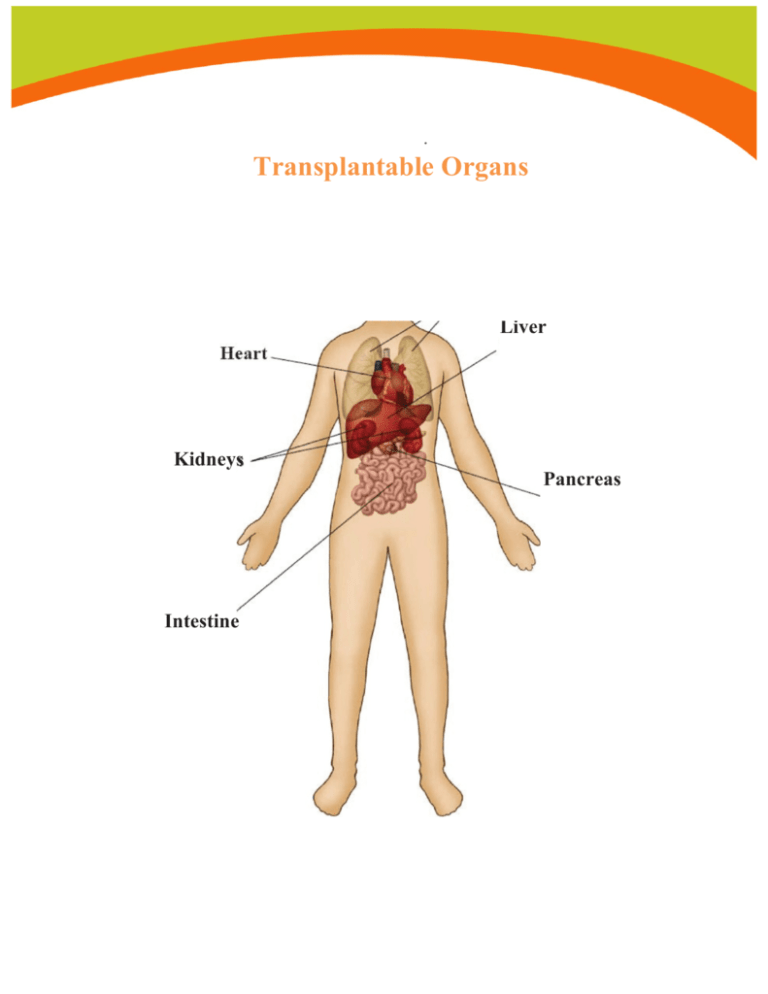
. Transplantable Organs Liver Kidneys Intestine Pancreas Organ Information Heart • The body’s hardest working muscle, the heart beats 70 times each minute as it pumps blood throughout the body. • Some conditions that can make a transplant necessary are cardiomyopathy, heart failure, myocarditis, and heart disease. • Hearts can be preserved outside of the body for 4-6 hours. Pancreas • The pancreas produces insulin, a hormone that helps the body use glucose (sugar) for energy, and enzymes that break down fat, protein and carbohydrates during digestion. • The pancreas controls the level of glucose in the blood. It is often transplanted with a kidney, because diabetes affects both organs. Conditions that might necessitate a pancreas transplant are diabetes or pancreas failure. • The pancreas can be preserved outside of the body for 2-14 hours. Kidney • Blood flows from the heart through the aorta and into the kidneys, which filter wastes and water from the blood and balance the body’s fluids. • While waiting for a kidney transplant, many patients undergo dialysis, to clean toxins out of blood. • Some conditions that could make a kidney transplant necessary are high blood pressure, diabetes and cystic kidney disease. • Ethnic minorities are four times more likely to develop kidney failure. • Kidneys are the most commonly transplanted organ & most in need. • Kidneys can be preserved up to 36 hours outside of the body. Liver • The liver is a complex organ that has more than 500 known functions. It breaks down harmful substances in the blood, produces bile that aides in digestions and stores vitamins, sugars and fats. • A donated liver can sometimes be split between two recipients, so one donor can be the source of two liver transplants. • Birth defects of the liver or bile duct, chronic liver infections like Hepatitis or drug/alcohol damage may necessitate a liver transplant • Livers have a preservation time of 4-16 hours outside of the body. Lung • The trachea or windpipe carries air to the lungs, where alveoli-tiny air sacs that are like folded balloons-extract oxygen and exchange it for carbon dioxide. • A single lung can save a life. One donor can be the source of two transplants. • Some conditions that could necessitate a lung transplant are cystic fibrosis, pulmonary hypertension, emphysema, and pulmonary edema. • Lungs have a preservation time of 4-6 hours outside of the body. Intestine • The intestines digest food and absorb nutrients back into the blood stream. • Most intestinal transplants are performed on infants and children. • Some conditions that could make a transplant necessary are twisted or blocked intestines or short-gut syndrome. • Intestines can be preserved for 8-16 hours outside of the body. Transplantable Tissue Eye and Tissue Information Donor Tissue Transplanted Tissue Applications Benefits to Recipients Sclera • Repair eyelid, reinforce wall of eye. Also used to repair ruptured ear drums Maintain structure; restores hearing Cornea • Replace diseased or dam-­‐ aged cornea Prevents blindness; restores vision Bone • Whole segment replacement, hip resection, spinal fusion, dental procedures Avoid amputation, promote healing, maintain mobility, structure Tendons • Replace damaged tissue Restore mobility, independence Ligaments • Replace damaged rotator cuff; used for bladder suspension Restores independence in activities of daily living Cartilage • Repairs congenital and traumatic Restores normal facial facial deformity appearance Heart Valves • Repairs congenital heart defects, traumatic injury, and replaces diseased and dam-­‐ aged valves. Life-­‐saving procedure for children. An alternative to prosthetic valve transplants. Prevents need for life-­‐ long anticoagulant (blood thinner) medication. Blood Vessels • Bypass surgeries • Replace blocked or clogged veins below knee Avoid secondary surgical site, amputation; restore circulation due to clogged veins and arteries Skin • Burn and wound protection Prevent infection, dehydration Collagen • Reconstruction, bladder slings, vocal cord injections Repair defects, scarring Eye Musculoskeletal Cardiovascular Other Tissue Skin • Skin can be used to aid in the healing process for severe burn victims, for those who suffer from a disfiguring injury, or disease. • Donated skin grafts will protect recipients from infection while promoting regeneration of their own skin. • Skin is removed from the back of the legs and the back, about the thickness of a severe sunburn peal. • Donation of skin does not interfere with funeral viewing arrangements. Upper Body Bone • Bones consist of living protein fibers that constantly rebuild themselves. • The radius, ulna and humerus are the bones in the arm that can be removed. • Bones can be transplanted in order to prevent amputation, promote healing maintain mobility, and structure. • After the bone and soft tissues are recovered, procurement technicians replace the bone with prosthetics. Bone & Connective Tissue • Bone and connective tissues include tendons, ligaments and cartilage. • The gift of bone and connective tissues helps individuals with various orthopedic and neurosurgical conditions. • These tissues will be used in a variety of back, joint, and leg surgeries such as hip replacement, knee reconstruction, and spinal fusion. • After the bone and soft tissues are recovered, procurement technicians replace the bone with prosthetics. Veins • Arteries carry oxygenated blood from the heart to the rest of the body, and veins bring the deoxygenated blood back. • Many people lose circulation in their legs, or even in their heart, due to disease or trauma. • Donated veins are used to restore circulation in heart bypass surgeries and to avoid leg amputation for people suffering poor circulation. Eye Cornea • The Cornea is the clear, dome-shaped window covering the front of the eye. There are more nerve endings in the cornea than anywhere else in the body making it one of the most sensitive parts of the body. • Traumatic accidents to the eye, infections, and inherited eye diseases like Keratoconus are just a few reasons why cornea donation can fill such a great need. • Almost anyone can donate their corneas, even individuals with diabetes or cancer. Whole Globe • After the cornea has been recovered, the sclera (the white part of the eye) can be utilized to repair eyelids and reinforce the wall of the eye. • Sclera can be used to repair ruptured ear drums to restore hearing. Research • Organs are not recovered for the sole purpose of research, once removed, if organs are found to be unsuitable for transplant or a recipient cannot be found, they may be provided for research. • When registering, you are not consenting for your entire body to be donated for research.
